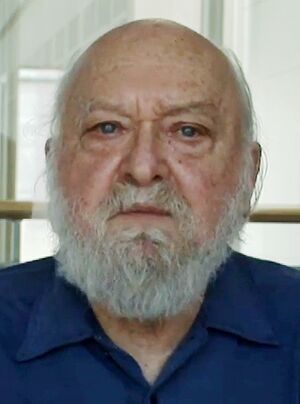Leo Kadanoff facts for kids
Quick facts for kids
Leo Kadanoff
|
|
|---|---|

Leo P. Kadanoff
|
|
| Born | January 14, 1937 New York City, New York
|
| Died | October 26, 2015 (aged 78) |
| Nationality | American |
| Education | Harvard University (BS, PhD) |
| Known for | Renormalization group theory of phase transitions Application of operator algebras in statistical mechanics Universality Baym–Kadanoff functional |
| Awards | Wolf Prize in Physics (1980) Elliott Cresson Medal (1986) Lars Onsager Prize (1998) Lorentz Medal (2006) Isaac Newton Medal (2011) |
| Scientific career | |
| Fields | Theoretical physics |
| Institutions | University of Chicago |
| Doctoral advisor | Paul Martin |
| Doctoral students |
|
Leo Philip Kadanoff (January 14, 1937 – October 26, 2015) was an important American physicist. He was a professor of physics at the University of Chicago. He also served as a past president of the American Physical Society (APS). Kadanoff made big contributions to understanding how matter behaves. He studied areas like statistical physics, chaos theory, and condensed matter physics.
Contents
Early Life and Education
Leo Kadanoff grew up in New York City. He went to Harvard University for his college education. There, he earned his degrees in physics by 1960. After studying more in Copenhagen, Denmark, he became a physics professor. This was at the University of Illinois in 1965.
Understanding Phase Transitions
Kadanoff's early work looked at superconductivity. This is when materials can conduct electricity with no resistance. In the late 1960s, he started studying how matter changes. These changes are called phase transitions. Think about ice melting into water or water boiling into steam. These are everyday examples of phase transitions.
Kadanoff showed that sudden changes in materials could be understood. He used ideas called scaling and universality.
- Scaling means that the behavior of a material looks similar. This is true whether you look at it up close or from far away.
- Universality means that different materials can behave in similar ways. This happens when they go through a phase transition.
With his team, he explained how these ideas applied to many changes. These were called second-order phase transitions. His ideas have since been used in many fields. These include computer science, biology, and even urban planning. For his important discoveries, he won several awards. These included the Wolf Prize in Physics in 1980.
Career and Later Work
In 1969, Kadanoff moved to Brown University. He found connections between how solids behave and how cities grow. This helped him contribute to city planning in Rhode Island.
In 1978, he joined the University of Chicago. There, he became a distinguished professor of physics and mathematics. Later in his career, he focused on chaos theory. This field studies complex systems that are very sensitive to small changes. He was recognized for his work. In 1982, he was elected a Fellow of the American Academy of Arts and Sciences.
Kadanoff received the National Medal of Science in 1999. This is one of the highest honors for scientists in the United States. It was awarded by President Bill Clinton. He was also a member of important scientific groups. These included the National Academy of Sciences. He also received the Lars Onsager Prize in 1998.
He co-wrote a textbook called Quantum Statistical Mechanics. This book is still used by many students today. Kadanoff also helped create the Center for Presentation of Science. This center is at the University of Chicago.
In 2013, a new center was named after him. It was called the Leo Kadanoff Center for Theoretical Physics. This center helps scientists study theoretical physics. Leo Kadanoff passed away on October 26, 2015. In 2018, the American Physical Society created a prize in his honor. It is called the Leo P. Kadanoff Prize.
Images for kids


